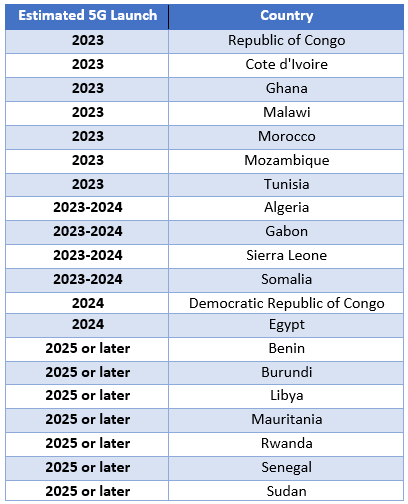Fiber Optic Trends to Overshadow 5G RAN
by Andrew Lui

The radio access network (RAN) is a crucial component of any mobile network, as it is responsible for transmitting and receiving data over the air to and from mobile devices. The RAN has evolved significantly over the years, with each new generation of mobile technology bringing improvements in speed, capacity, and coverage.
In recent years, the deployment of 5G networks has been a major trend in the radio access network space. 5G networks are designed to be faster and more efficient than previous generations of mobile networks, and they are expected to support a wide range of applications and services with high speeds and low latencies. Mobile operators around the world began to focus on upgrading their RAN equipment to support their deployment of 5G networks, as they look to take advantage of the benefits that 5G technology has to offer.
However, as more and more markets have made commercial 5G available, the focus on radio access network deployments has started to decline. One reason may be that with each launch of commercial 5G, there is less need for further investments in the RAN. While there may still be some opportunities for RAN deployments in emerging markets or in areas where coverage is limited, it feels like the focus for many mobile operators is shifting to the fiber optics network.
5G RAN Deployments Slowing Down
Commercial 5G is now available and offered by major service providers in North America, Europe as well as several parts of Asia and Africa. In the United States the big three carriers all have 5G nationwide. The carriers in Canada have launched in major cities. According to the 5G Observatory quarterly report 17, 72% of the population has 5G coverage within the 27 countries of the EU. In Asia and Africa, it’s a bit spottier, with some countries having wide 5G coverage and other countries still preparing for spectrum auctions.
In regions with mobile 5G services launched and widely available, their carrier service providers won’t feel as much pressure to jump on the bandwagon anymore and may decide to build new 5G RAN at a more leisurely pace. This may lead to less capex allocated to the RAN, which is reflected in industry analyst reports.
Recent reports and data from major telecom industry analysts, show that there is a downward trend starting to happen. Reports from Dell’Oro mentioned that they saw a second consecutive quarterly decline for the mobile RAN market and data from Omdia shows the same. LightCounting sites global uncertainties, supply chain constraints and foreign exchange softening the RAN market.
That being said, 5G is still in its initial stages in Latin America, Africa and parts of Asia. So, there are still opportunities for there, although it is expected to happen in piecemeal as each region will likely finalize their plans for 5G and release spectrums at different times. For example, based on our research here’s a table of potential 5G releases coming up in Africa over the next few years.

Expected 5G Launches in Africa
The Benefits of XR Optics
With the 5G available in over 70 countries around the world, we can see why the focus is shifting away from RAN. What are service providers focusing their attention and perhaps their spending budget on now? From the looks of things, it’s the fiber optics infrastructure.
Service Providers Gearing up for More Fiber Buildouts
Fiber optics, or optical fibers, are long cables made from glass no thicker than a human hair. Fiber optic cables are used as part of the wireline transport network to carry data from the access network to the service provider core network. With the advent of 5G there has been a massive push for more fiber optics as the technology of choice for mobile backhaul connectivity.
It makes sense that once the 5G RAN is in place, the supporting backhaul network will also be needing an upgrade. In most cases, the fiber backhaul network is what will connect 5G cell sites to the core network. Customers also expect fast upload/download speeds, low latency services, and stability with 5G. So, the backhaul network has to be upgraded to accommodate, otherwise 5G is going to have a hard time meeting customer expectations. To put it another way, you’ve got to have a wide enough freeway to support a large onramp, otherwise you’ll just end up with bad traffic on the freeway.
5G also requires the need for a multitude of small cells for network coverage, which may also require additional fiber networks in places where there was none.
Here are some noteworthy activities from service providers focused on expanding their fiber network’s footprint:
• T-Mobile might be stepping into the fiber business with a JV
• AT&T formed a JV with BlackRock for fiber wholesale
• Vodacom to expand fiber footprint with merger
With a potential global recession on the horizon, service providers may also be in a difficult position to acquire the capital needed for investing in new fiber buildouts. Where as in the US, there is quite a bit of federal funding put into broadband rollouts, in Europe most of the investment seems to be led by the private sector. This isn’t stopping many EU service providers from acquiring the resources needed. Looking at the activities, many are creating new capital with some clever maneuvers using their cell tower assets. Below are some of the tower spin offs from service providers in the EU that resulted in big financial turnouts:
• Deutsche Telekom spun off 40,000 towers to GD Towers and sold 51% stake to Brookfield and DigitalBridge
• Orange spun off 26,882 towers to Totem
• TIM spun off 23,000 towers to Inwit and sold a portion of stake to Ardian
• Telefonica spun off 31,000 towers to Telxius and sold to American Tower
• Vodafone spun off 82,000 towers to Vantage and sold a portion to GIP and KKR
2023 Trends for RAN and Fiber Optics
The trend in fiber optic deployments is expected to pick up steam in 2023. I expect service providers will continue to put more emphasis on fiber to the premises buildouts and expanding their fiber infrastructure as a whole to bolster the reliability and stability of their 5G network services. In addition, the fiber rollouts also give service providers an opportunity to upgrade their network’s bandwidth to 400G. This additional bandwidth will allow them to support the continuous growth in data traffic.
As for the RAN, I expect it to still be a significant part service provider capex, since there are still several regions that have yet to start 5G deployments. However, I feel in 2023, we may lean more into the services and applications instead.
